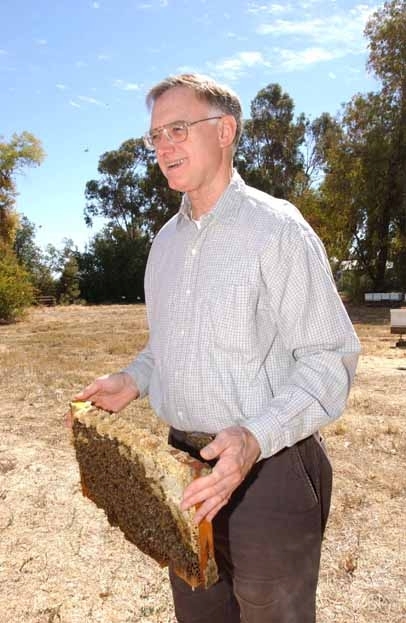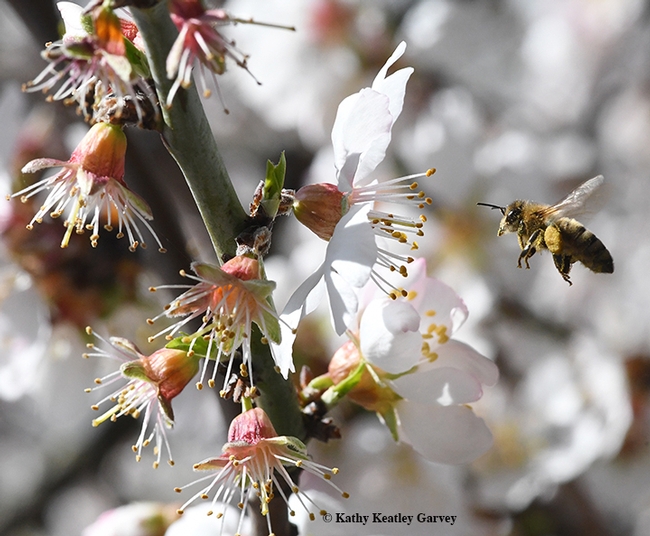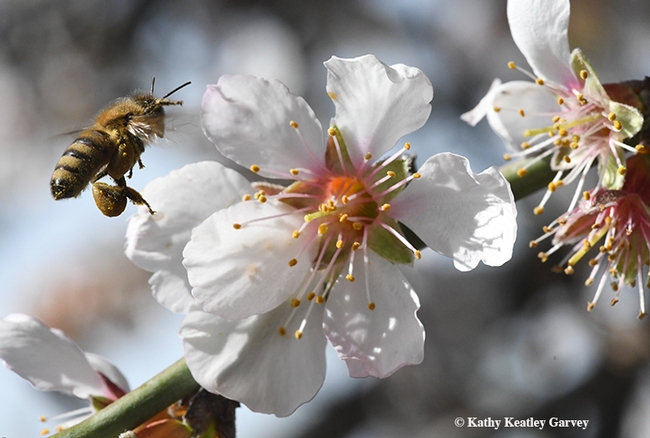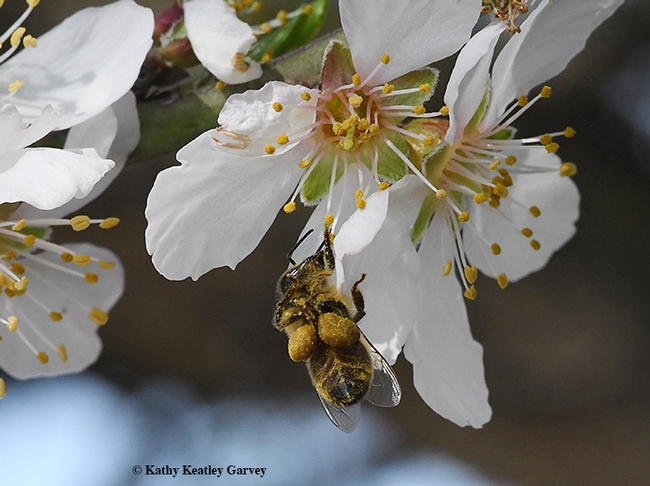
And it's definitely not a good time to be a honey bee.
The wind-whipped storms that are ravaging California are wreaking havoc on the state's almond pollination season, says honey bee guru Eric Mussen, Extension apiculturist emeritus, UC Davis Department of Entomology and Nematology, and president of the Western Apicultural Society.
The situation: California's million acres of almonds require two hives per acre for pollination. Without bees, no almonds.
Honey bees usually fly when temperatures reach around 55 degrees. During inclement weather, they hole up inside their hives. They're so unlike our postal workers who vow that “neither rain, nor snow, nor sleet” can stop mail delivery. Unfavorable weather for bees? Think "no-fly zone."
Mussen, California's Extension apiculturist for 38 years before retiring in 2014, continues to maintain an office in Briggs Hall, UC Davis, and respond to inquiries about honey bees. Not one to say "no," Mussen is serving a sixth term as president of the Western Apicultural Society (WAS), which was founded at UC Davis and gearing up for its 40th anniversary meeting Sept. 5-8 Davis.
And the steady rain we're having? How will that affect the pollination season?
“Rain," said Mussen, "is hard on the almond bloom for a few important reasons." He lists five reasons:
- Rain frequently is accompanied by cooler weather, which delays bloom. But, the delay can last only a short while, and then the flowers open and shed pollen, despite the weather. Honey bees usually neither forage on damp or wet blossoms, nor fly in the rain.
- If pollen grains come into contact with water, the water enters the openings in the pollen grains, through which the pollen tubes are supposed to emerge. The water is absorbed by the living protoplasm in the pollen grain and bursts its contents.
- Free water tends to transport spores of fungal, and sometimes bacterial, diseases to open flowers. Those microbes can invade the floral tissues, or in some cases, begin a journey through the flowers into the branches of the tree. When rain is imminent, growers usually will apply a fungicide to their trees to reduce the amount of infection. Frequent rains can promote multiple pesticide applications.
- By almond bloom time, honey bee colonies are collecting as much pollen as they can find, to feed an expanding brood nest. A prolonged period of inclement weather will interfere with nectar and pollen foraging, and leave little food to raise be brood. Lack of incoming pollens can reduce brood rearing, sometimes even to the point of the adult workers consuming most of the younger brood to save the nutrients for better times.
- Beekeepers who are used to seeing their colonies increase from 8-10 frames of bees to 10-12 frames during almond bloom may be disappointed this year due to a situation that is beyond their control. Providing supplemental feed can help their bees to a limited extent, but we have no supplemental feed that matches the nutritional value of mixed pollens.
Mussen says that native, solitary bee species, such as the blue orchard bee, also can be impacted negatively by continuous wet weather. “Foraging flight is curtailed, pollens and nectars are diluted or washed away, nesting sites can be flooded, and preferred or required floral sources may not be available that year,” he said. “This can have substantial negative impacts on the size of the following generation.”
Bottom line: it's not a good time for almond growers, beekeepers, and bees.
Attached Images:

During a sun break on Feb. 12, 2017, a pollen-laden honey bee heads for more almond blossoms in Benicia. (Photo by Kathy Keatley Garvey)

Adjusting her load of pollen, a honey bee buzzes toward another almond blossom on Feb. 12 in Benicia. (Photo by Kathy Keatley Garvey)

A honey bee with "saddlebags" of pollen foraging in an almond tree on Feb. 12 in Benicia. (Photo by Kathy Keatley Garvey)